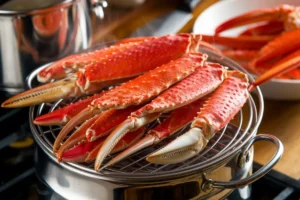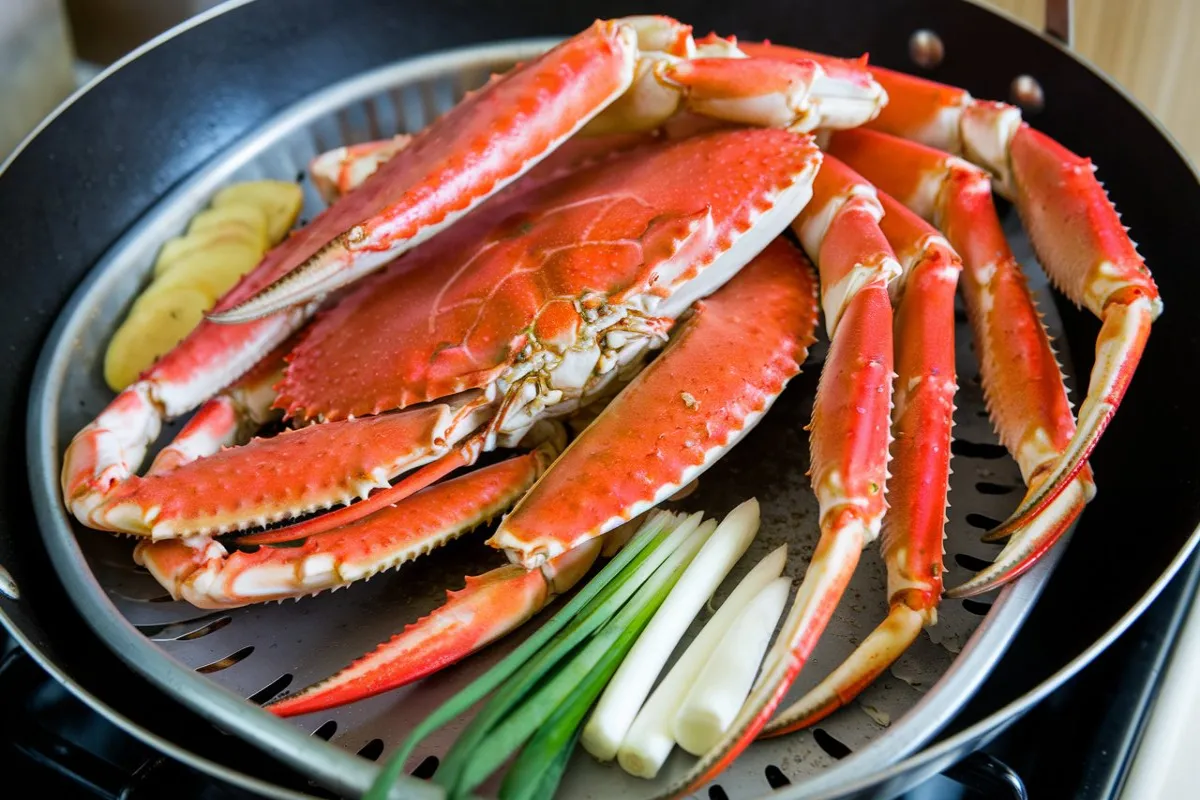Why Cooking Frozen Snow Crab Legs Correctly Matters
When preparing frozen snow crab legs, the cooking method you choose can greatly impact the taste and texture of the final dish. Overcooking or improper preparation leads to tough, chewy crab meat—an unfortunate result when working with high-quality seafood. Proper cooking will retain the crab’s natural sweetness and juicy texture.
Typically, snow crab legs are pre-cooked and flash-frozen, meaning your goal is to reheat them without losing flavor or moisture. Whether you opt for steaming or boiling, reheating the crab legs properly ensures you get the best possible outcome.
For those looking to preserve the natural flavor, steaming often comes highly recommended. You can check out this detailed guide on how to steam crab legs. On the other hand, boiling provides a chance to infuse additional flavors through seasoning. For a step-by-step guide on this method, take a look at how to boil snow crab legs.
Steaming vs. Boiling: Key Differences
Steaming tends to be the more delicate method of cooking frozen snow crab legs, helping to retain their natural flavor and texture. Here’s why steaming is preferred by many:
- Process: Crab legs are placed in a steamer basket over boiling water, allowing steam to gently heat them.
- Equipment: A large pot with a steaming rack or a steamer basket.
- Time: It usually takes about 5-6 minutes for thawed crab legs and 8-10 minutes for frozen ones.
- Flavor Impact: Steaming preserves the natural sweetness of the crab meat by preventing it from being submerged in water.
Those who prefer the purest taste of snow crab legs often choose steaming. The gentle nature of this method ensures the crab legs remain firm and juicy.
Boiling
Boiling, on the other hand, is often used when you want to cook large quantities of snow crab legs or add extra flavors. Here’s how boiling compares:
- Process: Crab legs are submerged in boiling water, which can be seasoned to impart additional flavors.
- Equipment: A large pot, water, and seasonings such as salt, garlic, or Old Bay seasoning.
- Time: Boiling typically takes about 4-6 minutes for thawed crab legs and around 10 minutes for frozen ones.
- Flavor Impact: Boiling allows for flavor infusion, as the crab absorbs the water and seasonings, although some of the natural flavor may be diluted.
Boiling tends to be faster, especially when cooking for larger groups, and is an excellent choice for those who want to experiment with seasonings.
Benefits of Steaming Snow Crab Legs

Steaming snow crab legs offers several advantages, particularly for those who want to maintain the natural flavor of the crab:
- Flavor Retention: Since the crab legs aren’t submerged in water, their natural juices stay intact, preserving the delicate, sweet flavor.
- Better Texture: The gentle heat from steaming results in firmer crab meat, ideal for those who prefer a sturdier texture.
- Healthier: Steaming requires no additional fats or oils, and there is less risk of losing nutrients compared to boiling.
How to Steam Frozen Snow Crab Legs:
- Fill a large pot with about an inch of water.
- Place a steamer basket or steaming rack inside the pot.
- Bring the water to a boil, then place the frozen crab legs into the basket.
- Cover the pot and steam for 8-10 minutes until heated through.
- Serve immediately with melted butter and lemon wedges.
Steaming is a great method if you enjoy the natural, unaltered flavor of seafood.
Benefits of Boiling Snow Crab Legs
Although steaming is great for maintaining natural flavors, boiling snow crab legs has its own set of benefits, particularly when flavor infusion is the goal:
- Faster for Large Quantities: Boiling is a more efficient method when preparing larger amounts of crab legs, as you can cook many at once.
- Enhanced Flavor Through Seasoning: Boiling allows for seasonings like garlic, salt, or herbs to be absorbed into the crab legs, offering a more intense flavor.
- Tender Meat: Boiling typically results in softer, more tender crab legs, which some diners prefer.
How to Boil Frozen Snow Crab Legs:
- Fill a large pot with water, adding your choice of seasonings like garlic, salt, or Old Bay.
- Bring the water to a rolling boil.
- Submerge the frozen crab legs in the water.
- Boil for 8-10 minutes or until fully heated.
- Drain the crab legs and serve with your favorite dipping sauces.
Boiling is the way to go if you enjoy more flavorful crab legs with a softer, tender texture.
Taste and Texture Comparison
When it comes to taste and texture, the differences between steaming and boiling are quite pronounced.
Taste:
- Steaming: This method preserves the natural sweetness of the crab, making it ideal for those who love the pure flavor of seafood.
- Boiling: Allows for flavor customization, thanks to the seasonings added to the boiling water. However, some of the crab’s natural flavor may be diluted by water absorption.
Texture:
- Steaming: Produces firmer crab legs, with the meat retaining its structure and juiciness.
- Boiling: Results in a more tender, melt-in-your-mouth texture, as the crab absorbs some water during the process.
Your preference for taste and texture will largely dictate which method you find more appealing. If you prefer crab in its most natural form, steaming is the better choice. For those who enjoy experimenting with flavor combinations, boiling may offer more flexibility.
Nutritional Comparison: Steamed vs. Boiled Crab Legs

From a nutritional standpoint, both steaming and boiling are healthy options, but each has its nuances.
- Nutrient Retention: Since the crab doesn’t come into direct contact with water, it retains more nutrients, including essential minerals.
- Lower Sodium: If you’re watching your sodium intake, steaming is better as it doesn’t involve adding salt to the cooking water.
Boiling:
- Caloric Impact: Boiling won’t add calories on its own, but if you heavily season the water or serve the crab with butter, it could raise the calorie count.
- Nutrient Loss: Some nutrients may leach into the water during boiling, especially if the crab legs are submerged for an extended period.
Both methods produce healthy, low-fat meals rich in protein, making snow crab legs a nutritious addition to any diet.
Steaming or Boiling for Different Occasions
Choosing between steaming and boiling snow crab legs can also depend on the occasion and number of diners.
- Ideal for Small Gatherings: Steaming works well for smaller dinners where you want to focus on the natural taste of the crab legs.
- Health-Conscious Meals: For a healthier meal with minimal added seasonings, steaming is the preferred method.
Boiling:
- Perfect for Large Groups: If you’re cooking for a crowd, boiling is faster and allows you to prepare more crab legs at once.
- Great for Flavor Customization: If you enjoy experimenting with different seasonings, boiling offers more versatility to enhance the crab’s flavor.
Both methods work well, but choosing the right one for the occasion will enhance your meal’s overall experience.
Expert Opinions and Chefs’ Preferences
Professional chefs and seafood experts have their preferences when it comes to cooking snow crab legs.
- Chefs Who Favor : Many chefs argue that steaming retains the crab’s natural juices and keeps the flavor intact. They recommend this method for diners who want the purest taste.
- Boiling for Big Batches: Boiling is favored by chefs when cooking large amounts of crab legs at once. The ability to infuse the crab with flavors through seasonings like garlic, lemon, or Old Bay makes this a popular choice in restaurants.
Ultimately, both methods are widely used in professional kitchens, with the decision largely depending on the desired outcome in flavor and texture.
Common Mistakes to Avoid
To ensure your frozen snow crab legs turn out perfectly, here are a few common mistakes to avoid:
Overcooking
One of the biggest mistakes is overcooking the crab legs. Overcooked crab becomes tough and chewy. Stick to the recommended cooking times to ensure tender, flavorful meat.
Not Using Enough Water for Steaming
Ensure you use enough water to generate plenty of steam. A lack of steam can result in unevenly cooked crab legs. Keep the lid on to trap the steam and avoid opening it during cooking.
Over-Seasoning When Boiling
When boiling, use moderate amounts of seasoning. Too much seasoning can overpower the delicate flavor of the crab. Stick
to simple seasonings like salt, garlic, and herbs. Over-seasoning can mask the natural sweetness of snow crab legs, which is one of their best attributes.
Not Thawing Crab Legs (If Necessary)
While you can cook crab legs directly from frozen, thawing them first can reduce cooking time and ensure more even heating. To thaw, place the frozen crab legs in the refrigerator overnight. Alternatively, you can run them under cold water for faster thawing.
Serving Crab Legs Cold
Make sure to serve the crab legs while they’re still hot. Crab legs that sit too long after cooking can lose their tenderness and flavorful juices. If you’re preparing them in advance, keep them warm by covering them with foil or placing them in a warm oven.
Frequently Asked Questions (FAQs)
How long should I steam frozen snow crab legs?
Steam frozen snow crab legs for about 8-10 minutes, or until they are fully heated. If the crab legs are thawed, steam them for 5-6 minutes.
Do you thaw frozen crab legs before cooking?
While you can cook them straight from frozen, thawing the crab legs first can help ensure even cooking and reduce overall cooking time. Thaw in the fridge overnight or use cold water for a quicker thaw.
What is the best way to cook snow crab legs?
Both steaming and boiling work well, but the best method depends on your preferences. Steaming retains the natural flavor, while boiling allows for more seasoning flexibility.
How do you know when crab legs are done?
Since frozen snow crab legs are pre-cooked, you are simply reheating them. They are done when fully heated through, and the shell has a bright red-orange color.
Can you overcook snow crab legs?
Yes, overcooking crab legs can make the meat tough and rubbery. Be sure to follow the recommended cooking times: 8-10 minutes for frozen crab legs, and 4-6 minutes for thawed.

Conclusion: Which Method is Best?
When it comes to cooking frozen snow crab legs, both steaming and boiling have their merits. Your choice ultimately depends on your preferences for flavor, texture, and the occasion.
- Steaming is ideal for those who love the natural, unaltered flavor of crab and prefer a firmer texture. It’s a healthy and simple method that retains the crab’s natural juices and nutrients.
- Boiling works well for those who want to add extra flavors to their crab legs and are cooking for larger groups. It’s a faster method and allows for more flavor customization through the addition of seasonings.
Whether you choose to steam or boil, you’re sure to enjoy delicious, tender snow crab legs that will impress any seafood lover. Experiment with both methods to find which one suits your taste best, and enjoy your meal!

